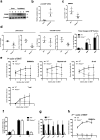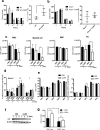CGRP-CRLR/RAMP1 signal is important for stress-induced hematopoiesis
- PMID: 30674976
- PMCID: PMC6344543
- DOI: 10.1038/s41598-018-36796-0
CGRP-CRLR/RAMP1 signal is important for stress-induced hematopoiesis
Abstract
Ecotropic viral integration site-1 (EVI1) has a critical role in normal and malignant hematopoiesis. Since we previously identified high expression of calcitonin receptor like receptor (CRLR) in acute myeloid leukemia (AML) with high EVI1 expression, we here characterized the function of CRLR in hematopoiesis. Since higher expression of CRLR and receptor activity modifying protein 1 (RAMP1) was identified in immature hematopoietic bone marrow (BM) cells, we focused on calcitonin gene-related peptide (CGRP), a specific ligand for the CRLR/RAMP1 complex. To elucidate the role of CGRP in hematopoiesis, Ramp1-deficient (Ramp1-/-) mice were used. The steady-state hematopoiesis was almost maintained in Ramp1-/- mice; however, the BM repopulation capacity of Ramp1-/- mice was significantly decreased, and the transplanted Ramp1-/- BM mononuclear cells had low proliferation capacity with enhanced reactive oxygen species (ROS) production and cell apoptosis. Thus, CGRP is important for maintaining hematopoiesis during temporal exposures with proliferative stress. Moreover, continuous CGRP exposure to mice for two weeks induced a reduction in the number of BM immature hematopoietic cells along with differentiated myeloid cells. Since CGRP is known to be increased under inflammatory conditions to regulate immune responses, hematopoietic exhaustion by continuous CGRP secretion under chronic inflammatory conditions is probably one of the important mechanisms of anti-inflammatory responses.
Conflict of interest statement
The authors declare no competing interests.
Figures




Similar articles
-
The CGRP Receptor Antagonist MK0974 Induces EVI1high AML Cell Apoptosis by Disrupting ERK Signaling.Anticancer Res. 2022 Oct;42(10):4743-4752. doi: 10.21873/anticanres.15979. Epub 2022 Oct 3. Anticancer Res. 2022. PMID: 36191988
-
Localization of calcitonin receptor-like receptor (CLR) and receptor activity-modifying protein 1 (RAMP1) in human gastrointestinal tract.Peptides. 2012 Jun;35(2):202-11. doi: 10.1016/j.peptides.2012.03.020. Epub 2012 Mar 30. Peptides. 2012. PMID: 22484227 Free PMC article.
-
The influence of RAMP1 overexpression on CGRP-induced osteogenic differentiation in MG-63 cells in vitro: an experimental study.J Cell Biochem. 2013 Feb;114(2):314-22. doi: 10.1002/jcb.24375. J Cell Biochem. 2013. PMID: 22949393
-
Functional relevance of G-protein-coupled-receptor-associated proteins, exemplified by receptor-activity-modifying proteins (RAMPs).Biochem Soc Trans. 2002 Aug;30(4):455-60. doi: 10.1042/bst0300455. Biochem Soc Trans. 2002. PMID: 12196114 Review.
-
[Regulatory mechanisms of calcitonin gene-related peptide (CGRP) in skin inflammation].Yakugaku Zasshi. 2012;132(11):1211-5. doi: 10.1248/yakushi.12-00232-1. Yakugaku Zasshi. 2012. PMID: 23123709 Review. Japanese.
Cited by
-
Neuropeptides in gut-brain axis and their influence on host immunity and stress.Comput Struct Biotechnol J. 2020 Mar 4;18:843-851. doi: 10.1016/j.csbj.2020.02.018. eCollection 2020. Comput Struct Biotechnol J. 2020. PMID: 32322366 Free PMC article. Review.
-
CGRP physiology, pharmacology, and therapeutic targets: migraine and beyond.Physiol Rev. 2023 Apr 1;103(2):1565-1644. doi: 10.1152/physrev.00059.2021. Epub 2022 Dec 1. Physiol Rev. 2023. PMID: 36454715 Free PMC article. Review.
-
Neural control of immune cell trafficking.J Exp Med. 2022 Mar 7;219(3):e20211604. doi: 10.1084/jem.20211604. Epub 2022 Feb 23. J Exp Med. 2022. PMID: 35195682 Free PMC article. Review.
-
CGRP Signaling via CALCRL Increases Chemotherapy Resistance and Stem Cell Properties in Acute Myeloid Leukemia.Int J Mol Sci. 2019 Nov 20;20(23):5826. doi: 10.3390/ijms20235826. Int J Mol Sci. 2019. PMID: 31756985 Free PMC article.
-
Adrenomedullin-CALCRL axis controls relapse-initiating drug tolerant acute myeloid leukemia cells.Nat Commun. 2021 Jan 18;12(1):422. doi: 10.1038/s41467-020-20717-9. Nat Commun. 2021. PMID: 33462236 Free PMC article.
References
-
- Morrison SJ, Wandycz AM, Hemmati HD, Wright DE, Weissman IL. Identification of a lineage of multipotent hematopoietic progenitors. Development. 1997;124:1929–1939. - PubMed
Publication types
MeSH terms
Substances
LinkOut - more resources
Full Text Sources
Other Literature Sources
Molecular Biology Databases
Research Materials

